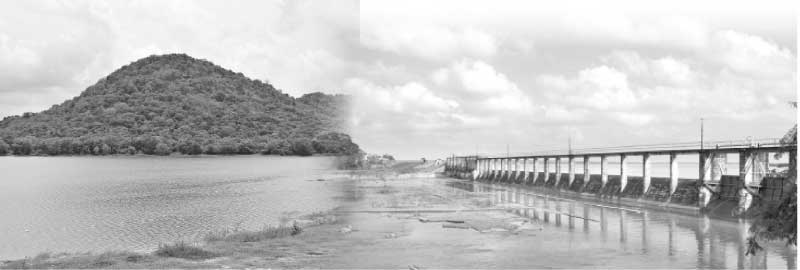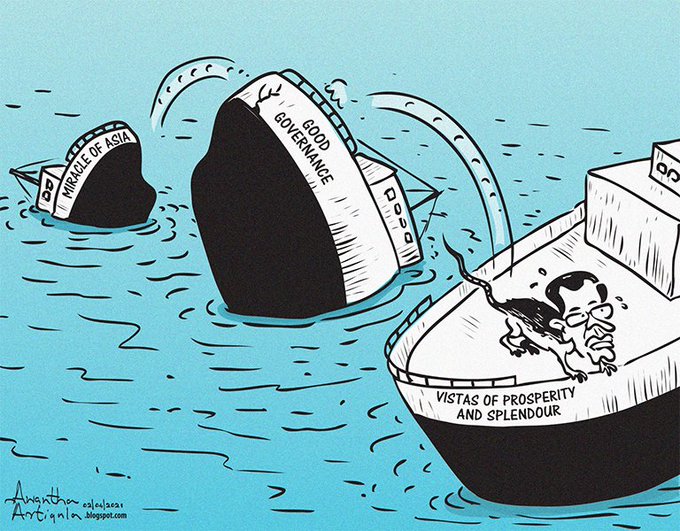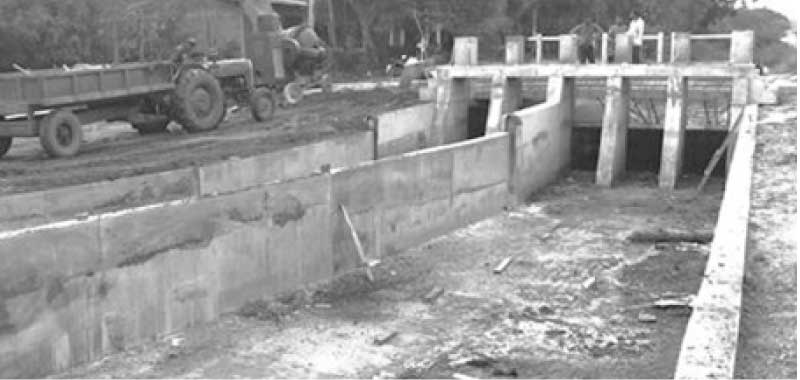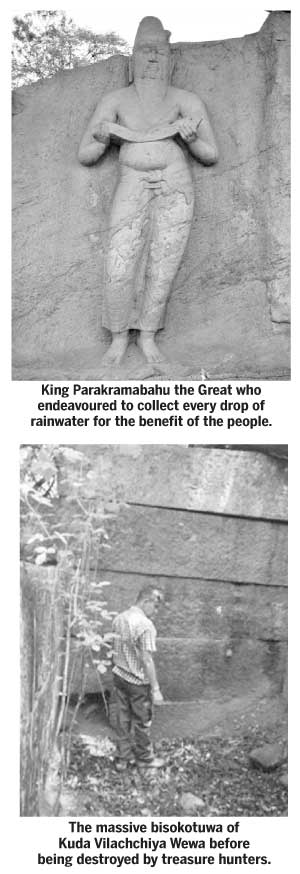 The greatness of the irrigation systems in Sri Lanka is a result of the remarkable engineering skills and workmanship showcased in the time of great kings. The progressive creation of a massive complex system of integrated tanks and cascade systems of storing and exchanging rainwater is marvellous and amazing.
The greatness of the irrigation systems in Sri Lanka is a result of the remarkable engineering skills and workmanship showcased in the time of great kings. The progressive creation of a massive complex system of integrated tanks and cascade systems of storing and exchanging rainwater is marvellous and amazing.
According to irrigation information sources, this year, the Irrigation Department has allocated Rs. 8,000 million to continue the construction work of 14 irrigation schemes under which around 13,350 hectares will receive adequate irrigational water. The ongoing irrigational schemes are Yan Oya Reservoir Project, Lower Deduru Oya Project, Kalugal Oya Reservoir Project, Morana Reservoir Project, Wellassa Navodya Project, Maha Galgamuwa Feeder Canal Project, Maha Gona Reservoir Project, Kaudulla Damsopura Extension Project, Godigamuwa Reservoir Project, Wilakandiya Reservoir Project, Kudawilachchiya tank renovation, Dematagala tank renovation and Ellawewa Reservoir Project. All funds required are completely invested by the Sri Lanka Government. The total estimated cost for completion of the ongoing 14 irrigational development projects is Rs 60,815 million.
Irrigation Minister Chamal Rajapaksa has instructed the Irrigation Director General and senior irrigation executives to take action to accelerate the construction work of these projects to enable the people to receive the benefits even during the project planning stage.
According to senior irrigation engineers, the main reason for the delay in completion of irrigation projects is the change of Governments, political interference, lack of funds, differences of opinion between the Irrigation Ministry, the Irrigation Department and other stakeholders, the delay in amending the present Irrigation Ordinance including out-of-date laws and regulations and the absence of a suitable regulatory process. They point out the construction of the Lower Malwathu Oya Reservoir in Thanthirimale in the Anuradhapura District which has not yet commenced although the foundation stone was laid thrice since 2013, the latest in 2019, by former Prime Minister Ranil Wickremesinghe. With regard to the Anuradhapura Yan Oya Reservoir, although the reservoir along with its two main canals was completed two years back, the project has not yet been officially commissioned.
The construction work started in 2014 and still there is compensation amounting to around Rs 2,500 million waiting to be settled to the farmers who have lost their properties for accommodating the reservoir bearing a capacity of 149,000-acre-feet. Some lands have not been released by the Forest Department and the Government is paying a monthly allowance to the farmers at the rate of Rs 8,000 per family.
When speaking about the renovation, restoration, rehabilitation or modernization of ancient tanks, it is obvious that irrigation officers are finding it difficult to attend to duties as per above under the existing irrigational laws and regulations, such as governing water resources development, riverine management, preservation of catchment areas, irrigational water management, preservation of water resources and existing irrigation projects and in commencing new projects. Irrigation officers, while planning construction and management of irrigation systems, confront numerous inconveniences and complexities due to ambiguities in the present irrigation legislation, especially with regard to the delegation of authoritative powers from top to bottom.
Anuradhapura Government Agent R.M. Wanninayake told the Daily News that a large number of tank reservations are in the grip of encroachers who clear the reserved landscape including tank beds for cultivation and housing which has resulted in large scale soil erosion, accumulation of sediment in the tanks thus contracting tank capacity and the destruction of tank bunds and the irrigation canals affiliated to the tanks causing water contamination and environment pollution at large.
He said there are several stakeholders concerning the custody of the tanks – Irrigation Department, Provincial Irrigation Department, Agrarian Development Department, Mahaweli Development Authority, Ceylon Electricity Boardand the National Water Supply and Drainage Board thus sometimes creating problematic situations in the distribution of funds, sediment disposal, land distribution, water management, lawsuits against vandals and procurement issues.
In the Anuradhapura District, around 1,500 acres belonging to the tank reservations of mainly Padaviya, Huruluwewa, Mahakanadarawa, Thissawewa, Nachchaduwa, Rajangane and Wahalkada are in the grip of encroachers, and as disclosed at the District Agriculture Committee meetings, the menace is growing. This situation highlights another loophole in the Irrigation Ordinance, in that the district irrigation directors have not been delegated powers for taking direct legal action against the vandals as all legal matters such as filing cases for the evacuation of encroachers and land acquisition are performed remotely only by the Legal Department of the Irrigation Department in Colombo.
As explained by the Government Agent, the majority of the tanks, mainly the major reservoirs in the Anuradhapura District, are exposed to encroachers and antisocial elements since the boundaries of the tanks are not earmarked with boundary stones or demarcation fences. This lapse is directly responsible for the ruin of tanks. This issue is often raised and discussed at the district coordinating meetings and District Agriculture Committee meetings and no fruitful and productive action has been taken so far.
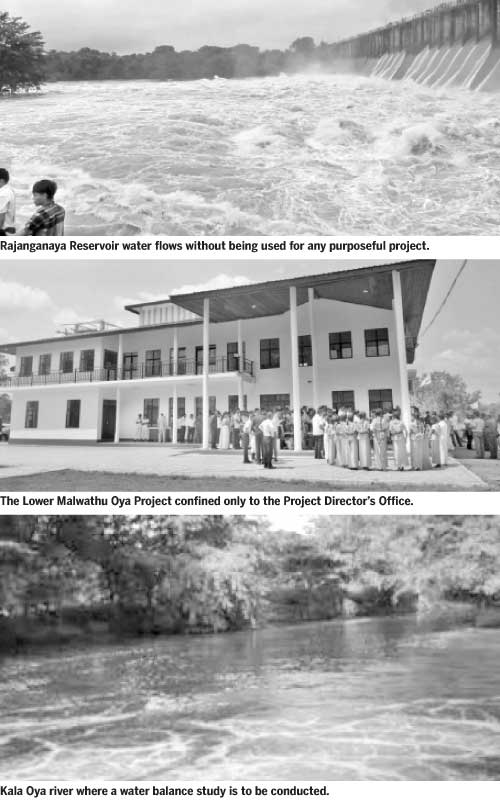
Rural areas in the country are lagging behind in access to improved drinking water. Globally more than eight out of 10 people are without access to drinking water sources. In this context, it is a timely requirement to streamline the irrigational and drinking water management since in most cases the tanks are the main water source for feeding drinking water projects. Issues such as amending the present Irrigation Ordinance, conducting water balance studies in major river basins, vesting the authoritative power for administering the country’s tank resources to the Irrigation Department are to be taken up for enforcement with necessary amendments, revisions and reforms being instituted, on par with the awakening in the field of irrigation development programmes such as Wari Saubhagya (Irrigation Prosperity), Wew Gam Pubuduwa as well the Pivithguru Ganga river protection programme in accordance with the President’s ‘Saubhagyaye Dekma’ (Vistas of Prosperity and Splendour) policy manifesto.
In the absence of a single authority dealing with irrigation, the Wari Saubhagya programme is handled by a number of institutions such as the Irrigation Department, Irrigation Ministry, Agrarian Development Department, Provincial Irrigation Departments and Mahaweli Authority creating complications in regulatory and implementation mechanisms. It is envisaged to complete the 5,000 rural tanks renovation target by 2023 and continue the programme covering around 15,985 working tanks, 2,100 abandoned tanks and 15,800 anicuts in the country, at a cost of Rs 12.5 billion.
It is learnt that the Wew Gam Pubuduwa tank renovation programme is also being affiliated to Wari Saubhagya Project since both programmes are implemented to achieve the same target to a major extent. Under the Wew Gam Pubuduwa it was planned to renovate 350 small tanks under 30 tank cascades at a cost of Rs. 3,113 million.
With regard to the Irrigation Department’s Pivithura Ganga river protection programme launched in 2018, it is learnt that the Environment Ministry too has embarked on a project called Surakimu Ganga (Let’s Protect Rivers) for saving the 103 main rivers in the country from destruction mainly due to unwarranted human activities such as dumping garbage, gem mining and sand mining, and soil excavation. This situation leads to a complicated episode in deciding the custodianship of the major river basins in the country.
The revision of the Irrigation Ordinance is identified as an urgent need under the current context of water management on par with the Saubhagye Dekma policy manifesto and the mega irrigation development schemes such as Wari Saubhagya, Wew Gam Pubuduwa and Pivithuru Ganga. Irrigation experts say that the Irrigation Department which is nearly 120 years old, possesses an invaluable practical experience in the engineering and technological components.
This is the right time for investigating whether the subjects such as water resource development, riverine management, catchment area preservation, rainwater harvesting and irrigational water management are under the control of the Department. It is learnt that funds worth Rs. 2,000 million has been allocated for the Surakimu Ganga project whereas Rs. 500 million has been allocated for the Irrigation Department to proceed with the Pivithuru Ganga programme although both agencies work for the protection and maintenance of the 103 river systems in the country.
In this context, there could be a controversy creating misunderstanding among the various stakeholder agencies coming under the Irrigation Ministry and the Environment Ministry. In the time of ancient kings in Sri Lanka the feudal system was in effect with regard to irrigation.
The British rulers revoked the feudal system and consequently the tanks system started facing decay. Under these circumstances, they passed the first Irrigation Ordinance called Irrigation and Paddy Fields Cultivation Ordinance No 09 of 1856. Then consequently, in 1946, 1951, 1968, 1973, 1983, 1990 and 1994 at various stages this Ordinance was amended depending only on the emerging necessities.
